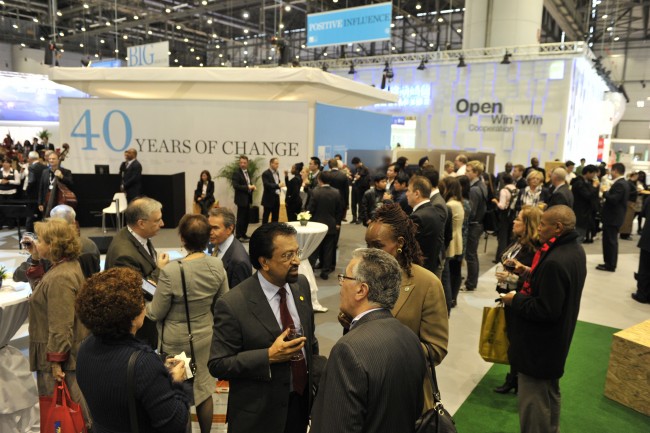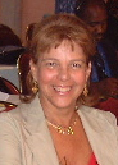ITU Telecom World Celebrates its 40th Anniversary
by Roxana Dunnette
Geneva, Switzerland, November 1, 2011-Telecom World took place in Geneva, Switzerland from 24 to 27 October 2011, an event that focused on the latest technologies, services, regulatory issues and trends in the telecommunications sector. It was also the 40thanniversary of the ITU Telecom event that started in Geneva in 1971. This year’s event was the 12thedition, having been previously held every four years. Over 300 VIPs, head of states and governments, ministers, CEOs of global corporations attended the event this year to celebrate this important milestone.
“Broadband for the Global Good”and “Forum for Change” were the main focus but also featured thematic exhibitions and national pavilions showcased applications, smart living and digital innovations.
 “As the leading UN agency for ICT issues, ITU is uniquely positioned in being able to bring the public and private sectors together for ITU Telecom World, opening doors that otherwise remain shut, stimulate debates that without it would remain silenced and creating networks of industry peers who together can drive real global change,” said ITU Secretary-General Dr. Hamadoun Touré.
“As the leading UN agency for ICT issues, ITU is uniquely positioned in being able to bring the public and private sectors together for ITU Telecom World, opening doors that otherwise remain shut, stimulate debates that without it would remain silenced and creating networks of industry peers who together can drive real global change,” said ITU Secretary-General Dr. Hamadoun Touré.
The main event was however the “Broadband Leadership Summit” that set the tone for the role of broadband as a critical infrastructure for economic growth, climate change challenges, knowledge and education on global access.
The Broadband Commission for Digital Developmentheld on 23 October, under the patronage of President H.E. Paul Kagame of Rwanda and ITU Secretary-General Dr. Touréset four new targets for 2015 to stimulate the global introduction of broadband at accessible prices:
1. Making broadband policy universal. By 2015 all countries should have a national broadband plan or stra-tegy to conform to Universal Access Services.
2. Making broadband affordable.By 2015 first level of broadband services should be made affordable in developing countries at a cost of less than 5% average monthly household income.
3. Connecting homes to broadband. By 2015 40% of households in developing countries should have Internet access.
4. Getting people online. By 2015 Internet user’s penetration should reach 60% worldwide, 50% in developing countries and 15% in Least Developed Countries (LDCs).
In order to achieve those targets and bring the benefits of ICTs to all, the political will is necessary together with private sector commitment and requires work at the local level to develop the adequate policy and regulatory framework, business models and financing, introduce fair taxation and stimulate content production in local languages.
A broad spectrum of subjects were discussed in other sessions including: Cloud computing, Internet of the Future, Mobile Banking, LTE Deployment, Cyber Security, Transition from Analogue to Digital TV, Climate Change and ICTs, E-Health, Child Online Protection, Connectivity on the Move, Broadband in the developing world, among others.
A special one-day event has been dedicated to “Digital Cities” where mayors, experts in utilities, city planners and technology innovators gathered to discuss the urban future where physical and virtual realities are connected.
With the WRC-12 conference coming up in January 2012 several sessions have been dedicated to spectrum issues. Some ideas came up as good initiatives to the efficient use of the spectrum like: good migration from one generation to another, from narrowband to broadband convergence of networks and services, and optimization of what we have .
Mobile broadband will require a lot of bandwidth and in order to avoid spectrum scarcity some possible measures have been discussed as well:
- Taxation and the best way to provide coverage by reinvesting in the sector;
- Digital dividends to be used for convergent services to consumers;
- Video as the driver for local broadband content;
- Convergence of networks, ie. cable, satellite & wireless;
- Reducing the response time (now 10-11 years) from the allocation of spectrum to entry into use of the service;
- Use of the white space;
- Improvement of fixed networks;
- Cognitive management of the spectrum;
- Consolidation of networks, and sharing of networks in rural areas.
Developing countries not having much terrestrial infrastructure rely heavily on mobile services and have difficulties to reduce the digital divide as they have to face the challenge coverage obligations vs. spectrum allocation.
Although this was not a dedicated satellite conference some speakers emphasize the role of satellites in bridging the digital divide and achieving the United Nations’ Millennium Goals.
One was O3b Networks which announced US$ 1.5 billion in fundraising to deliver broadband content to 177 countries using a constellation of satellites. That will help the decentralization of Internet traffic, offer good quality video and affordable mobile broadband in developing markets.
On the exhibition floor some applications using satellites are worth mentioning:
- The African country of Gabon presented “Surveillance Environnementale Assiste par Satellite” (SEAS) an innovative Central African project that resulted from the Copenhagen Convention on ICT and Climate change. The project will use satellite teledetection system for the responsible management of resources in Central Africa. The Excellence Center and the station uplink in Libreville with a radius of 2800km will process data and high definition images from satellites to monitor and manage forestry resources, water, urbanization and climate change.
- CONECTADA was the name of the Argentinean pavilion showing the country’s satellite network covering all remote areas for distribution of full video Internet content.
- The Japan pavilion highlighted the concept of “Smart Living” with Smart networks featuring applications such as digital signage using solar power, intruders’ detection, speech to speech translation on smart phones, and personal authentication technologies. The Pavilion also displayed new Disaster Readiness Measures using satellites. Japan is committed to re-establishing communications in disaster affected areas by making greater use of satellite and wireless communications as a priority and the establishment of a reliable broadband wireless communication system in a smart society using satellite-terrestrial hybrid systems.
- ICT QATAR & Partners presented MADA, the Qatar Assistive Technology Center in Doha where people with various disabilities can access Internet, study, read books, play games using assistive technologies now available on the market.
ITU Telecom World event attracted 6,500 on-site participants, 332 global leaders in the Broadband Leadership Summit and 234 exhibitors from 41 countries. A global audience of 10,000 schools, 100,000 telecenters and hundred of thousands of people were connected via webcasting and twitter.
The Forum concluded with a “Manifesto for Change,” created from all discussions that took place at the event with Heads of states, ICTs ministers, industry leaders and participants on site and from around the world. The Manifesto recognizes the importance of broadband for socio-economic development in a connected world and a knowledge society where “communication is a human need and a right.” ITU encourages world leaders to take appropriate regulatory and policy measures to facilitate private sector implementation of this change.
A major change announced this year at the show is that the ITU Telecom World will now be held every year with the next one to be held in Dubai, UAE in October 2012.
------------------------------------
 Roxana Dunnette is the Executive Director, of R&D MEDIA, based in Geneva, Switzerland. She has had an extensive career in Broadcasting and media including senior management positions at Worldspace, CBS and PBS in New York covering primetime sports and news events, and internaat the United Nations in New York and the International Telecommunication Union as US government representative. She can be reached at: roxana.dunnette@ties.itu.int
Roxana Dunnette is the Executive Director, of R&D MEDIA, based in Geneva, Switzerland. She has had an extensive career in Broadcasting and media including senior management positions at Worldspace, CBS and PBS in New York covering primetime sports and news events, and internaat the United Nations in New York and the International Telecommunication Union as US government representative. She can be reached at: roxana.dunnette@ties.itu.int
.





